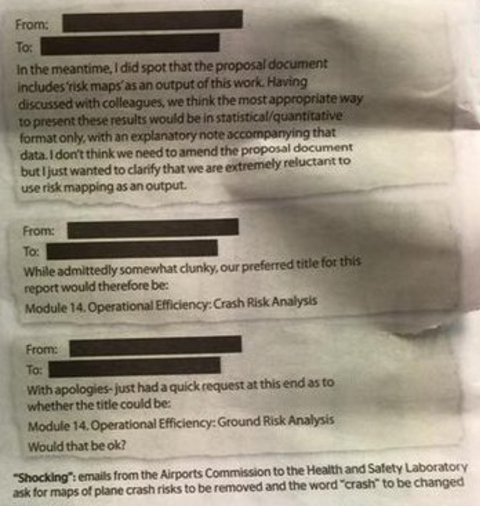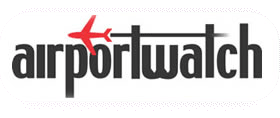Airports Commission not only downplayed crash risk of new runway, but got the word “crash” removed from report title
Many people are very concerned about the safety implications of adding another runway, especially at Heathrow, where hundreds of thousands of people are over flown. It has now been shown that though the Airports Commission (AC) did have a study done by the Health & Safety Laboratory (HSL), in May 2015, it downplayed its findings. The Standard says that confidential documents and emails it obtained showed the AC, which backed a third runway, got the title of an independent study on aircraft crashes changed to remove the word “crash”. Unsurprisingly and obviously, adding another 50% more planes at Heathrow, or 100% more at Gatwick would increase the risk of a crash. The Standard says the AC rejected “risk maps” showing the increased likelihood of an aircraft crash around London airports if expansion went ahead. Instead the AC’s Final Report said “ the changes to the background crash rate are minimal, regardless of whether or not expansion takes place at the airports.” It failed to mention the HSL conclusions that the likelihood of a crash on take-off or landing increased by up to 60% with a 3-runway Heathrow and doubled under one scenario with a 2-runway Gatwick. Daniel Moylan said the cover-up was “truly shocking.” People living under approach routes (higher risk than take-offs) should know their risks. The future flight paths are not yet know, so those living under them are unaware of the risk. The dangers of drones, laser beams and terrorism are not included – nor the risk to those on the ground.
.
Tweet
The report
This is the link to the report done for the Airports Commission by the Health & Safety Laboratory, in May 2015. Published by the Commission on 1.7.2015
Image below shows some emails indicating the Airports Commission did not want the word “crash” in the report’s title, or maps indicating crash risk.

Heathrow expansion: Risk of plane crash ‘was hidden by airport panel’
8.12.2015
Britain’s Airports Commission was today accused of a “cover-up” over plane crash dangers to Londoners from a third runway at Heathrow.
The panel came under fire after it emerged that it rejected “risk maps” showing the increased likelihood of an aircraft crash around London airports if expansion went ahead.
Confidential documents and emails obtained by the Standard also showed the commission, which backed a third runway, got the title of an independent study on aircraft crashes changed to remove the word “crash”.
In its final report, the panel included findings from the Health and Safety Laboratory study stating that the background rate for crashes would be virtually unchanged with another runway.
But it failed to mention the HSL conclusions that the likelihood of a crash on take-off or landing increased by up to 60 per cent with a three-runway Heathrow and doubled under one scenario with a second Gatwick runway.
Highlighting concerns about “contradictions” in the commission’s conclusions, Wimbledon Tory MP Stephen Hammond said: “[It] looks like a cover-up of the crash risk. Londoners need to have all the facts about the safety of the proposed expansion out in the open.” The Mayor’s aviation adviser, Daniel Moylan, said the emails were “truly shocking”.
The row over possible plane crashes, which are very rare, erupted ahead of Cabinet ministers meeting on Thursday to discuss airport expansion.
One option they are understood to be considering is delaying a decision until after the mayoral election in May, and ordering more work on air quality.
Tory mayoral candidate Zac Goldsmith, who has vowed to resign if the Government backs a third runway, signalled he may not quit if the Government asks Heathrow and Gatwick to “prove their plans can be reconciled with legal air quality commitments”.
Some Cabinet ministers are believed to still be pushing for a firm “direction” of support for a bigger Heathrow. The airports panel commissioned a report by the HSL into crash rates if Heathrow or Gatwick expanded.
The HSL experts offered to draw up contour maps, or a “heat” map showing transition from “cool” low risk to “hot” high risk of plane crash likelihoods. But this appeared to have sparked alarm at the commission.
An email from one official, whose named has been redacted, to the HSL on February 17, 2015, states: “Having discussed with colleagues… we are extremely reluctant to use risking mapping as an output.”
The maps would have shown which local communities were more likely to be affected by any aircraft crash. But Londoners were not given this information — and have also not been told by Heathrow which areas could be flown over by planes using a third runway. A confidential draft of the HSL report, dated May 6, 2015, also showed the title as “Assessment of the aircraft crash likelihood around Heathrow and Gatwick airports, with and without runway expansion.” An email from a commission official on May 19 asks for the title to be changed to “Module 14. Operational Efficiency: Crash Risk Analysis”. The next day, an email from the commission to the HSL asks for the word “crash” to be changed to “ground”.
The HSL study was published on the Airports Commission website. The commission stressed its final report had been subject to extensive analysis and consultation. A spokesman said: “The final Airports Commission report and the business case underpinning its recommendation took the points raised in this [HSL] report into account.”
Heathrow crash risk ‘raised by third runway’
7.12.2015
By NICHOLAS CECIL (Evening Standard)
A third runway at Heathrow could increase the likelihood of a plane crashing on take-off or landing by up to 60 per cent, the Standard reveals today.
The shock finding is in a review commissioned from the Health and Safety Laboratory by the Airports Commission. But the commission did not mention this heightened danger in its final report which backed a bigger Heathrow.
The revelation, which comes ahead of a crunch meeting of Cabinet ministers on whether to expand Gatwick or Heathrow, stunned campaigners against a third runway. City Hall accused the commission of “burying” the higher crash rate for an area within 10km (6.2 miles) from the airport.
Communities within this distance include Hounslow, Feltham and Twickenham to the east and Windsor to the west, and possibly even Windsor Castle and Richmond.
Tory mayoral candidate Zac Goldsmith has vowed to resign as MP for Richmond Park if David Cameron backs Heathrow expansion.
The risk of a Heathrow crash is still very small. The research found the likelihood of a crash at a three-runway Heathrow would be around one every 16 years, compared to roughly one in every 26 years without expansion.
The commission’s July report said the HSL had concluded “that the changes to the background crash rate are minimal” whether another runway is built or not.
But this rate measured the likelihood of a crash at least 10km from Heathrow or Gatwick. HSL experts analysed crash rates within 10km of an airfield, normally a take-off or landing.
They modelled possible changes between 2013 and 2050 and found for Heathrow the highest crash rate would be with an additional north-west runway. Their report added: “The scenario for Heathrow with the highest crash rates represents an increase of 60 per cent in the crash rate compared to 2013.”
For Gatwick the crash rate is more than doubled with a second runway, but risks are still lower than Heathrow.
Boris Johnson’s aviation adviser Daniel Moylan said: “The risk of a plane crashing into London is mercifully low but it is very strange that the Airports Commission has buried this proof that it will be higher with a third runway than without.”
A commission spokesman said evidence in its report “was subject to extensive analysis and consultation”, and Heathrow said it was “one of the safest airports in the world”.
International Development Secretary Justine Greening, MP for Putney, has warned that expanding Heathrow would increase the risk of a plane crash on London. She was accused of “scaremongering of the worst type” but now appears to have been vindicated.
http://www.standard.co.uk/news/transport/heathrow-crash-risk-raised-by-third-runway-a3131476.html
Some of the comments on these articles:
A crash is one thing, terrorists deliberately crashing a plane into Central London, or even into a packed football or rugby stadium is quite another. Did the Commission seek advice from the security services on the wisdom of otherwise of flying more places over a tightly packed city of 9 million? And if not, why not?
.
This does not take account of terrorism, or laser beams being pointed at plane cockpits damaging the vision of pilots, or of the increasing number of drones. All those significantly increase the risk of an accident.
.
The report
This is the link to the report done for the Airports Commission by the Health & Safety Laboratory, in May 2015. Published by the Commission on 1.7.2015
“EXECUTIVE SUMMARY
“4 CONCLUSION
What the Airports Commission actually said:
This is what the Airports Commission actually said, in its final report, on the issue of safety:
12.2
The objectives under the Operational Efficiency module are:
• to ensure individual airport and airports system efficiency;
• to build flexibility into scheme designs;
• to meet present industry safety and security standards; and
• to maintain and where possible enhance current safety performance with a view to future changes and potential improvements in standards.
—–
Safety considerations
12.23
The CAA’s Preliminary Safety Review of all three schemes found a number of issues
for more detailed investigation and resolution. More work would be needed on all
three schemes to resolve issues around missed approach procedures and obstacle
limitation surfaces, which define the generally permitted height for structures in the
vicinity of the runway, but this is not unusual for schemes at the assessed level of
development and none of these issues should be considered ‘show stoppers’.
12.24 The CAA did note the lack of precedent for the Heathrow Extended Northern
Runway concept and indicated that it would need more detailed development.
It was emphasised, however, that the CAA remained open-minded on the concept
and open to further engagement.
12.25 Following a review of consultation responses, the Commission asked the Health
and Safety Laboratory to review the scale of increase in crash risk associated with
each of the schemes. The review concluded “that the changes to the background
crash rate are minimal, regardless of whether or not expansion takes place at the
airports.”
—–
and
The Commission would expect detailed airspace designs to be agreed and safety-assured, following a final round of consultation, approximately 12 months before the opening date of the new runway
Airports Commission final report 1.7.2015
https://www.gov.uk/government/uploads/system/uploads/attachment_data/file/440316/airports-commission-final-report.pdf
.
.
.
.
